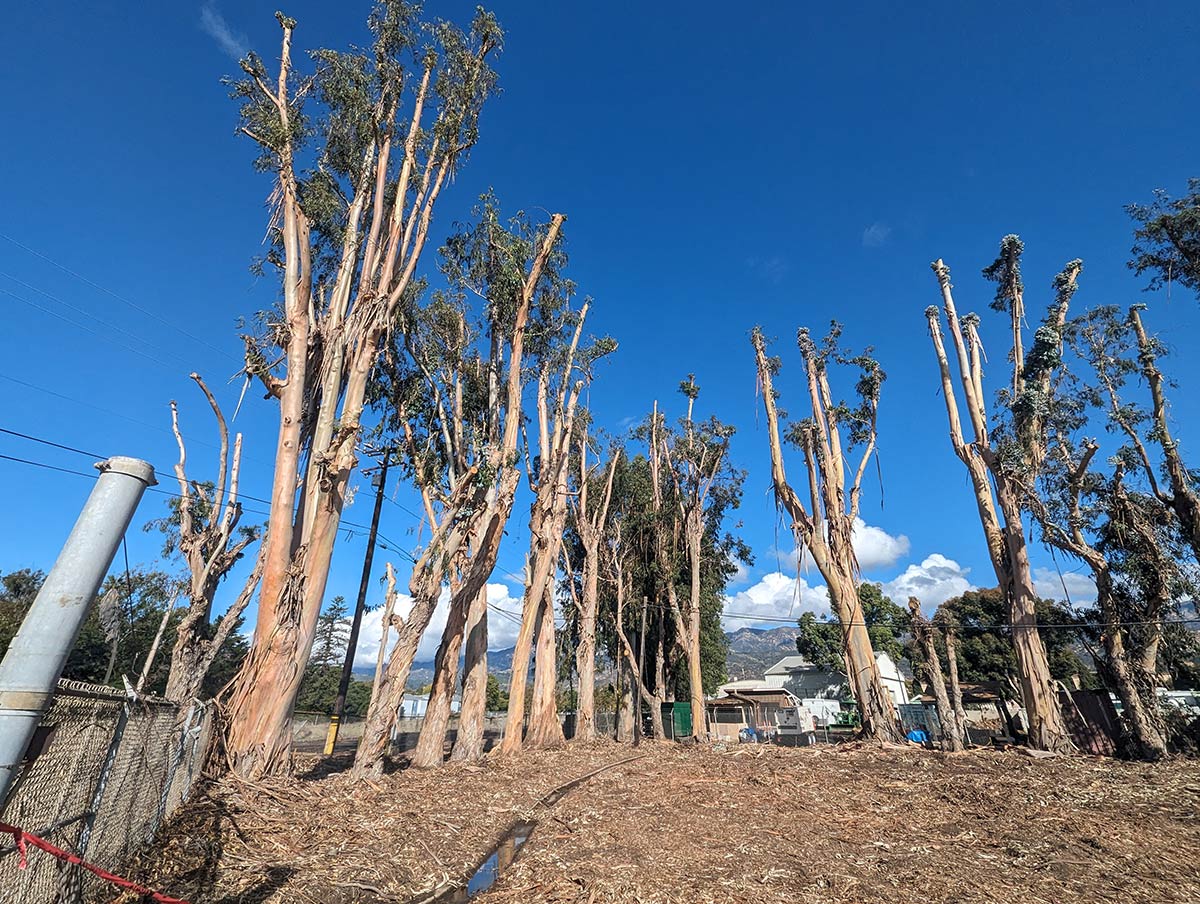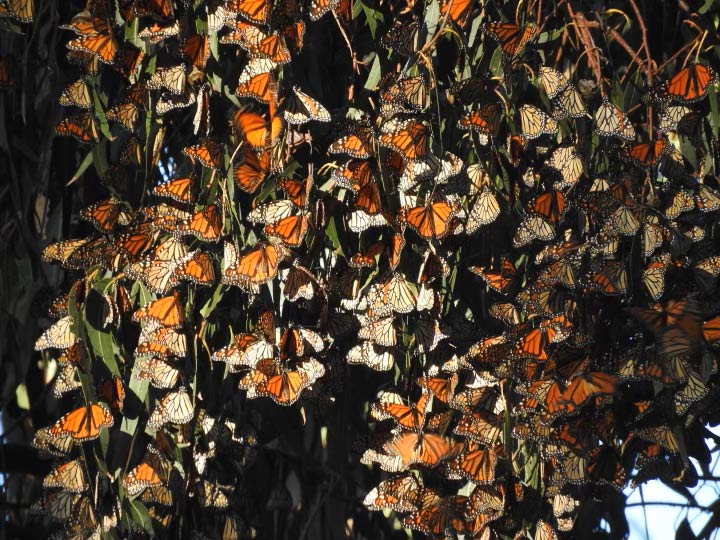Population tally is lower than last year, similar to 2021
Volunteers and partners with the Xerces Society’s Western Monarch Count have been busy counting butterflies this winter, and the final numbers are now in. The 27th annual Thanksgiving count ran from November 11 through December 3, 2023, totaling 233,394 butterflies across 256 overwintering sites in the western United States. This tally is slightly lower than last year’s, yet similar to the 2021 count. The overwintering population of western monarchs remains at approximately 5% of its size in the 1980s.

Highlights from the 2023 Western Monarch Count
The largest count at a single location was 33,080 monarchs at an overwintering site in Santa Barbara County owned by The Nature Conservancy. This site hosted the largest number of butterflies in 2022 as well; it is not open to the public. The second largest count was 16,038 monarchs at the Pismo State Beach Monarch Butterfly Grove and the third, 10,029 at the Morro Bay Golf Course, both in San Luis Obispo County.
High counts for other popular sites included:
- 305 butterflies at Albany Hill in Alameda County
- 1,093 at the Monarch Bay Golf Course in San Leandro County
- 10,000 at Lighthouse Field State Beach in Santa Cruz County
- 6,500 at Natural Bridges State Beach in Santa Cruz County
- 6,547 at the Pacific Grove Monarch Sanctuary in Monterey County
- 15,206 across the Ellwood Mesa complex (multiple sites) in Santa Barbara County
- 319 at Camino Real Park in Ventura County.
The Central Coast continued to host the majority of overwintering monarchs, with approximately 177,570 butterflies reported in San Luis Obispo and Santa Barbara County combined (76% of this year’s count).
Volunteer and partner-powered
Over 400 volunteers and partners registered for this year’s Western Monarch Count, an all-time record! During the three-week survey period, participants submitted more than 500 monarch count surveys and 200 habitat assessments.
One highlight was a visitor at the Pacific Grove Monarch Sanctuary in Monterey County, California, spotted a butterfly that had been tagged by the Southwest Monarch Study in northern Utah, meaning it had traveled over 700 miles. Additionally, participants identified four newly-recognized monarch overwintering sites, plus a handful of potential sites that will be surveyed again next season.
Our gratitude goes out to all the volunteers, partners and donors that make this annual effort possible. This work couldn’t happen without you!

Key takeaways from the count
The numbers tell a story, and this year's count is no exception. While we celebrate the resilience of western monarchs, we also recognize the challenges they face. Here are the main takeaways:
1. Western monarchs remain imperiled.
Migratory western monarchs remain at just 5% of their population numbers from the 1980s, when low millions overwintered along the California coast. When invertebrate populations are in decline, it’s common to witness populations fluctuate year to year. There are many factors that can influence how many butterflies show up at the overwintering sites each year, including temperature, rainfall, and the availability of milkweed and nectar resources across the West.
While it's difficult to predict how conditions from any single year influence the count, last year’s New Year’s count (a follow-up count performed each year) revealed the highest seasonal decrease on record following severe winter storms across the West Coast. This meant the population entered the spring breeding season with fewer butterflies. Summer observations were also generally lower than last year. So far this winter’s storm season has been mild, but early fall rains disrupted plant phenology – the timing of events such as flowering – and the prediction of strong El Niño winter conditions remains.
Despite ongoing efforts to preserve their migration, western monarchs face significant challenges. Primary threats to western monarchs include: loss or destruction of overwintering and breeding habitat, pesticide contamination of their habitat, and extreme weather conditions exacerbated by climate change. Understanding the factors contributing to western monarchs’ decline is crucial for effective conservation and management.

2. Protections are urgently needed.
Very little meaningful protection currently exists for migratory monarch butterflies and their overwintering habitat. For example, trees have recently been cut at an overwintering site in Bolinas in Marin County and a large overwintering site on Chevron’s property in Santa Barbara County, leading to reduced monarch numbers at both sites. These are locations within the coastal zone, which means they are technically legally protected as Environmentally Sensitive Habitat Areas. Yet functionally, many trees continue to be cut down, as the habitat is under-valued and their legal protections are not well known. The U.S. Fish and Wildlife Service’s proposed listing of monarchs under the federal Endangered Species Act (ESA) is expected this fall and, depending on the specifics of the listing decision, has the potential to provide protection to the important places that monarchs rely upon each winter.

3. Collaboration is leading to advances in monarch research.
Building off the May 2023 Western Monarch Overwintering Science Meeting in San Luis Obispo, CA, an exciting new applied science effort, the Western Monarch Overwintering Science Initiative (M.O.S.I), formed this year. M.O.S.I. is a new, evolving and highly collaborative group of people invested in advancing our collective understanding of western monarch overwintering, while engaging Californians in community science efforts and applied research projects. Two initial projects include a forest structure and cluster monitoring project and a movement ecology and wildlife tracking project, with fieldwork taking place at Pismo State Beach and Vandenberg Space Force Base.

4. Everyone has a role to play.
Actions you can take to ensure a brighter future for western monarchs include:
- Plant native milkweed and nectar plants. Create monarch-friendly spaces by planting native milkweed and nectar plants in your gardens. Check out Xerces’ pollinator conservation center and habitat kit program for helpful resources.
- Get involved locally. Join or support local conservation efforts dedicated to preserving monarchs and other at-risk pollinators. Volunteering for a local cause in your community is one way to get started. Take the Pollinator Protection Pledge to commit to working every day to protect pollinators and their habitats.
- Protect monarchs from pesticides. Reduce or avoid herbicide and insecticide use, especially systemic insecticides.
- Spread awareness. Share your knowledge and passion for monarch conservation with friends and family. Education is a powerful tool for change. Browse Xerces’ educational resources.
- Contribute to community science. Projects that track western monarchs include the Western Monarch Milkweed Mapper and Western Monarch Mystery Challenge, and nationwide Integrated Monarch Monitoring Program. iNaturalist is a great platform for recording observations of many organisms, including monarchs.
The Western Monarch Call to Action has more information about the steps you can take to make a positive impact for western monarchs.

About the Western Monarch Count
The Western Monarch Count (WMC) is a community science effort to collect data on western monarchs and their habitat during the overwintering season, which occurs from approximately October to March. The Thanksgiving count is the first of two official survey periods during the season, and it usually captures the height of clustering monarchs. The WMC is managed by the Xerces Society and count co-founder, Mia Monroe. Participants follow a standard protocol to survey overwintering habitat and estimate the number of butterflies in coastal California as well as northern Baja, Mexico and the greater Phoenix, AZ area. Data from the WMC are used to improve our understanding of the western monarch population status and their conservation needs.
Acknowledgements
A huge thank you to the hundreds of dedicated volunteers who collected data at overwintering sites. And, thank you to our western monarch conservation funders, who make this work possible: California Department of Fish and Wildlife, California State Parks Foundation, California Wildlife Conservation Board, Google.org, U.S. Forest Service International Programs, The Marion R. Weber Family Fund, Monarch Joint Venture, National Fish and Wildlife Foundation, San Diego Zoo Wildlife Alliance, The Taggart Saxon Schubert Fund, USDA Natural Resources Conservation Service, USDOI Bureau of Land Management, US Fish and Wildlife Service, and Xerces Society members.




